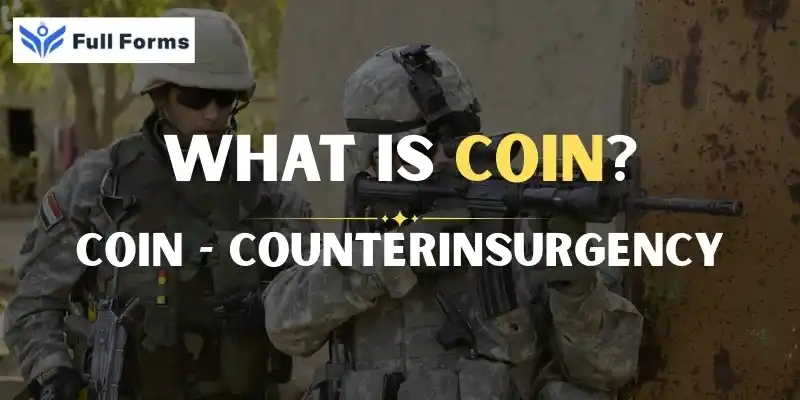Counterinsurgency
(COIN)

Description
You can't win wars on the battlefield anymore
It's not always about who has the most military power or whose weapons have done the most talking. Today's wars don't happen on battlefields; they happen in villages and between civilians, not soldiers fighting invisible enemies who don't even wear uniforms. That's where Counterinsurgency, or COIN for short, comes in.
Counterinsurgency isn't about beating armed rebels. It's about winning people's hearts, getting rid of the enemy's power over them, and building a stable state. In fact, it takes a mix of military, political, economic, and social efforts to deal with the insurgent military forces and restore legitimate governance.
Counterinsurgency is the full range of military and civilian actions taken to defeat an insurgency. Insurgency is when people work together to overthrow the current government through armed conflict, propaganda, and getting people to support them.
The goal of fighting insurgency isn't just to kill or capture insurgents; it's also to break their support network. The local people are the main part of the support mechanism, but they may not be because they are afraid, have a different ideology, or just don't like the current government.
To understand how counterinsurgency works, you need to first understand how insurgencies work. Most of the time, insurgents work in small groups and hide out in local communities. Their plan for fighting includes guerrilla warfare, which includes ambushes, sabotage, and surprise attacks. They usually don't fight directly in the military, but instead use a strategy of wearing down their opponent over time.
Most importantly, insurgents want to win over the people. The government loses its legitimacy if the people start to support or even put up with them.
Basic Ideas Behind Counterinsurgency
- Keep the people safe
The most important thing in any COIN strategy is to keep civilians safe from violence. People won't feel safe enough to work with the government or report insurgent activities if there isn't security. - Win over hearts and minds
You can't beat an insurgency with just military power. To gain people's trust, governments must offer services, justice, and good governance. People are less likely to support rebels if they think their needs are being met. - Getting Information
In counterinsurgency, information is the most powerful weapon. It's very important to know where insurgents are hiding, who is helping them, and how they work. People can only do this if they trust the government enough to give them information. - Military action that is specific
Using too much force in COIN operations can backfire. It is important to be precise, restrained, and respectful of human rights. Every death of a civilian makes more people likely to turn against the government. - Strengthen Local Resources
Training local security forces, making institutions stronger, and helping local governments take charge are all parts of a long-term COIN strategy. Foreign troops can help, but for peace to last, the people of the area must own it.
The "Clear, Hold, Build" Method
The "Clear, Hold, Build" model is used in many successful counterinsurgency operations:
- Use controlled and focused military action to get rid of insurgents in an area.
- Keep the area safe and keep insurgents from coming back to hold it.
- To make things stable in the long term, build up the local economy, infrastructure, and government.
This cycle needs to happen in every region until the insurgency is no longer strong.
Problems with Counterinsurgency
Even though COIN operations are very important, they have a lot of problems:
- In insurgent warfare, it's very hard to tell the difference between enemies and civilians.
- People may lose support because of the slow progress or perception of occupation.
- Cultural differences can make people feel like they don't belong.
- Insurgents are hard to beat with regular methods because they can change.
Also, COIN needs a long-term commitment. It's not just a few weeks or months; it's often years of hard work, money, and working together.
Examples from the real world
Afghanistan and Iraq
In the 2000s, both countries became important places for counterinsurgency efforts. The U.S. and coalition forces tried to stabilize the area and get rid of terrorist safe havens by using both military force and nation-building.
India's War Against Naxalites
The government has used both security operations and development programs to get people to stop supporting the rebels.
Colombia and FARC
Colombia fought the FARC guerrilla movement for years, using both military force and peace talks. A big part of the plan was to make rural areas better and bring former rebels back into society.
The Human Side of COIN
Counterinsurgency isn't just a job for the military; it's a very human job. It means earning trust, learning about the local culture, and sometimes holding back when provoked. Soldiers have to do a lot of things besides fight, like be diplomats, social workers, and engineers.
People start to believe in the system again during successful COIN operations. This isn't because they have to, but because it starts to work for them.
Final Thoughts
One of the hardest but most important parts of modern conflict is counterinsurgency. It teaches us that winning isn't just about beating your enemies; it's about making something better in their place.
